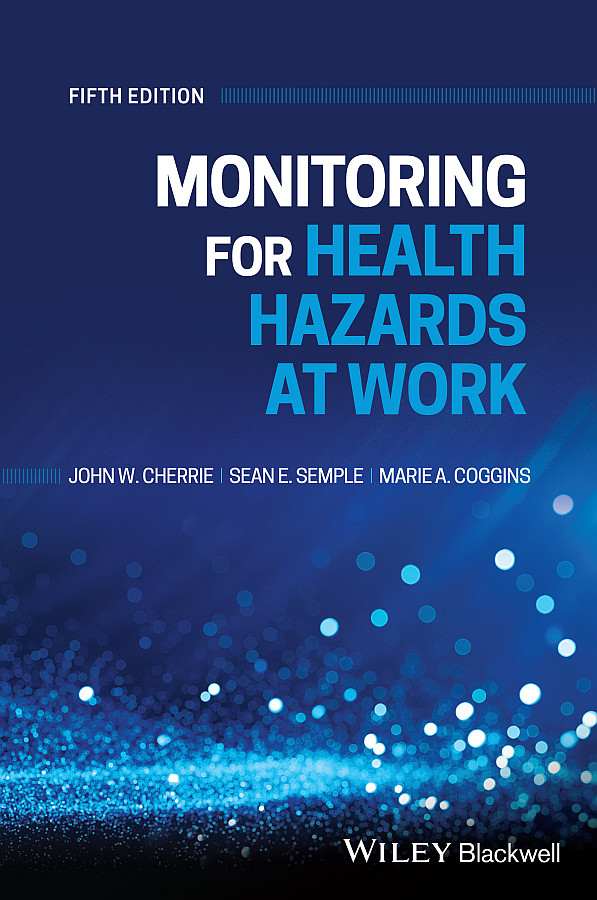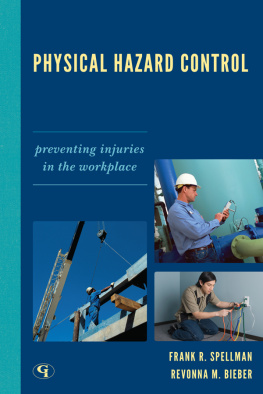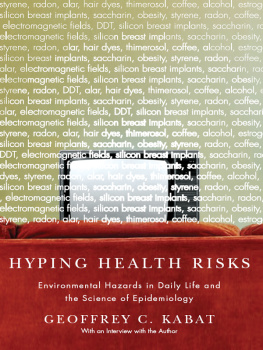
Table of Contents
List of Tables
- Chapter 1
- Chapter 5
- Chapter 8
- Chapter 12
- Chapter 14
- Chapter 16
- Chapter 17
- Chapter 18
- Chapter 20
- Chapter 22
- Chapter 23
- Chapter 24
- Chapter 25
- Chapter 26
- Chapter 28
List of Illustrations
- Chapter 1
- Chapter 3
- Chapter 4
- Chapter 5
- Chapter 8
- Chapter 9
- Chapter 12
- Chapter 14
- Chapter 15
- Chapter 16
- Chapter 17
- Chapter 18
- Chapter 20
- Chapter 21
- Chapter 22
- Chapter 23
- Chapter 24
- Chapter 25
- Chapter 26
- Chapter 27
- Chapter 28
Guide
Pages
Monitoring for Health Hazards at Work
FIFTH EDITION
John W. Cherrie
Institute of Occupational Medicine (IOM)
Edinburgh, UK
Sean E. Semple
University of Stirling
Stirling, UK
Marie A. Coggins
National University of Ireland Galway

This edition first published 2021
2021 John Wiley & Sons Ltd
Edition History
WileyBlackwell (4e, 2010)
All rights reserved. No part of this publication may be reproduced, stored in a retrieval system, or transmitted, in any form or by any means, electronic, mechanical, photocopying, recording or otherwise, except as permitted by law. Advice on how to obtain permission to reuse material from this title is available at http://www.wiley.com/go/permissions.
The right of John W. Cherrie, Sean E. Semple, and Marie A. Coggins to be identified as the authors of this work has been asserted in accordance with law.
Registered Offices
John Wiley & Sons, Inc., 111 River Street, Hoboken, NJ 07030, USA
John Wiley & Sons Ltd, The Atrium, Southern Gate, Chichester, West Sussex, PO19 8SQ, UK
Editorial Office
9600 Garsington Road, Oxford, OX4 2DQ, UK
For details of our global editorial offices, customer services, and more information about Wiley products visit us at www.wiley.com.
Wiley also publishes its books in a variety of electronic formats and by printondemand. Some content that appears in standard print versions of this book may not be available in other formats.
Limit of Liability/Disclaimer of Warranty
The contents of this work are intended to further general scientific research, understanding, and discussion only and are not intended and should not be relied upon as recommending or promoting scientific method, diagnosis, or treatment by physicians for any particular patient. In view of ongoing research, equipment modifications, changes in governmental regulations, and the constant flow of information relating to the use of medicines, equipment, and devices, the reader is urged to review and evaluate the information provided in the package insert or instructions for each medicine, equipment, or device for, among other things, any changes in the instructions or indication of usage and for added warnings and precautions. While the publisher and authors have used their best efforts in preparing this work, they make no representations or warranties with respect to the accuracy or completeness of the contents of this work and specifically disclaim all warranties, including without limitation any implied warranties of merchantability or fitness for a particular purpose. No warranty may be created or extended by sales representatives, written sales materials or promotional statements for this work. The fact that an organization, website, or product is referred to in this work as a citation and/or potential source of further information does not mean that the publisher and authors endorse the information or services the organization, website, or product may provide or recommendations it may make. This work is sold with the understanding that the publisher is not engaged in rendering professional services. The advice and strategies contained herein may not be suitable for your situation. You should consult with a specialist where appropriate. Further, readers should be aware that websites listed in this work may have changed or disappeared between when this work was written and when it is read. Neither the publisher nor authors shall be liable for any loss of profit or any other commercial damages, including but not limited to special, incidental, consequential, or other damages.
Library of Congress CataloginginPublication Data
Names: Cherrie, J. W. (John W.), author. | Semple, Sean E., author. | Coggins, Marie A., 1974 author.
Title: Monitoring for health hazards at work / John W. Cherrie, Sean E. Semple, Marie A. Coggins.
Description: Fifth edition. | Hoboken, NJ : WileyBlackwell, 2021. | Includes bibliographical references and index.
Identifiers: LCCN 2020035232 (print) | LCCN 2020035233 (ebook) | ISBN 9781119614968 (paperback) | ISBN 9781119614944 (adobe pdf) | ISBN 9781119614999 (epub)
Subjects: MESH: Occupational Diseasesprevention & control | Occupational Exposureprevention & control | Air Pollutants, Occupationaladverse effects | Noise, Occupationaladverse effects | Hazardous Substancesadverse effects | Risk Assessmentmethods
Classification: LCC RA1229 (print) | LCC RA1229 (ebook) | NLM WA 440 | DDC 615.9/02dc23
LC record available at https://lccn.loc.gov/2020035232
LC ebook record available at https://lccn.loc.gov/2020035233
Cover Design: Wiley
Cover Image: DKosig/Getty Images
List of Figures
| An idealized exposureresponse relationship. |
| A simple conceptual model of exposure routes: (a) inhalation; (b) dermal; (c) ingestion; (d) injection. |
| The ratio of near (NF) to farfield (FF) exposure levels in different conditions. |
| Exposure over a working shift. |
| Increase in dichloromethane concentration in a poorly ventilated room |
| Results from ten measurements of inhalable dust in a packing plant. |
| Results from 100 measurements of inhalable dust in a packing plant. |
| A logprobability plot showing data from ten measurements of exposure during bag filling. |
| Output from BWstat using the example data ( BSOH, reproduced with permission) |
| Diagram showing an isolator with exit/entry airlock ( Extract Technology, reproduced with permission) |
| Diagram showing a concrete surface grinder with dedicated dust collection shroud (on left) and in use connected to portable extraction system (on right) ( Bosch, reproduced with permission) |
| Diagram showing a fume cupboard (left) and large walk in booth (right), both examples of partial enclosures (Reproduced with permission from the UK Health and Safety Executive HSG 258). |
| Diagram showing the incorrect placement of a hood while welding, i.e. too far from the source. |
| The bar graph and frequency format diagram are often used to communicate risk estimates, example above from Ghosh et al., 2008 used to depict a 20%, 5 year estimated Gail model risk of invasive breast cancer in a hypothetical patient X. |
| The ISO/CEN/ACGIH sampling conventions for healthrelated aerosol fractions. (Reproduced with permission from Occupational Hygiene, 3rd edition, edited by Kerry Gardiner and J. Malcolm Harrington, Blackwell Publishing Ltd., 2005, p. 187.) |
Next page





